
Green is the Next Red, White and Blue: New York Times’ Friedman Scores with Laboratory Talk
Good News for Berkeley Lab in FY09 Budget Rollout
Green is the Next Red, White and Blue: New York Times’ Friedman Scores with Laboratory Talk
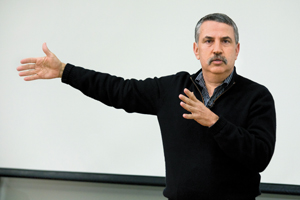
Speaking in the Building 50 auditorium this past Tuesday, Thomas L. Friedman, the Pulitzer Prize-winning columnist for the New York Times and the author of several books including the number one best-seller in 2005, The “World is Flat: A Brief History of the Twenty-First Century,” delivered what must surely rank as one of the most entertaining lectures ever heard on the Hill. In a talk that was simulcast to the Building 66 auditorium and Perseverance Hall, Friedman gave Lab employees and guests a preview of his forthcoming book, “Green is the Next Red, White, and Blue: America’s Mission in a World that is Hot, Flat and Crowded,” which is due out this summer.
“I am writing an energy book but it’s really a book about America,” Friedman said. “Since 9/11 we have lost our groove as a country and we need to get our groove back.”
Friedman’s central contention is that “green” technology is the pathway by which America can get her groove back, but he wants to “re-brand” the term “green” to a convey a new and much “more muscular and strategic” concept, which he has dubbed “geo-green.”
Said Friedman, “In the world of ideas, if you can name an issue you can own it. For so many years, the term green was defined by its opponents who wanted to disparage the idea. They defined green as liberal, tree-hugging, sissy, girlie-man, unpatriotic and vaguely French.”

Green technology needs to be re-branded so that it balances economic growth, energy and the environment. This balance is essential to retain the support of all the competing constituencies both at home and abroad. For example, he said, “Without economic growth as part of the mix, you cannot even begin to have a conversation with China, India or Brazil.”
Friedman’s concept of geo-green calls for systematic solutions to the problems of a world that has entered what he calls the “Energy Climate” era. The focus should be on “sustainable energy productivity,” which he defines as “how we get more and more, cleaner and cleaner, cheaper and cheaper, smarter and smarter electrons from fewer and fewer sources.” This is how we will compete and thrive in a future where the world’s population is projected to exceed 9 billion by the year 2053.
“There is nothing we would do to become the greenest country in the world that would not simultaneously propel us forward to become the most respected, most secure, most innovative, most entrepreneurial nation in the word,” Friedman said.
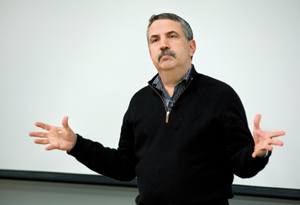
Friedman is a summa cum laude graduate from Brandeis University with an undergraduate degree in Mediterranean studies. He holds a Master’s degree in modern Middle East studies from Oxford, has served as a visiting professor at Harvard, and has been awarded several honorary degrees. He joined the New York Times in 1981 and went on to become a three-time Pulitzer Prize winner. He is currently on sabbatical from his foreign affairs column, which appears twice a week in the Times, and is syndicated to seven hundred other newspapers worldwide.
In “The World is Flat,” Friedman argued that globalization, through lightning-swift advances in technology and communication, has “flattened the world,” in the sense that the competitive playing field between developed and emerging nations is becoming increasingly leveled. This has created both opportunities and challenges. In “Green is the Next Red, White, and Blue,” he extends that argument to a world that is not only flatter, but also hotter and far more crowded.
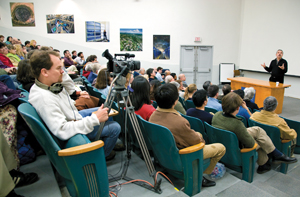
As a writer, Friedman is renowned for his sharp wit and keen insight. Both talents were on ample display in his Berkeley Lab talk. For example, he described corn ethanol in Iowa as being the definition of a “sub-optimal” option for green energy.
“By sub-optimal, I mean doing something really well that you shouldn’t be doing at all,” Friedman said.
He also called upon Al Gore to apologize for “underestimating global climate change;” compared the lobbying efforts of the American oil and auto industries to “assisted suicide;” observed that “the price of oil and the pace of freedom always move in opposite directions;” noted that without access to electricity, as is true for one out of every four persons in the world today, cell phones, laptops and other gadgets become “paperweights;” and pointed out that with citizens in China, India and elsewhere striving to live and consume at the same level as citizens in the United States, “We’re going to need two planets.”
Good News for Berkeley Lab in FY09 Budget Rollout
The Fiscal Year (FY) 2009 bud-get request submitted to Congress by the Administration on Feb. 4 contained very good news for Berkeley Lab. All DOE Office of Science program areas at the Laboratory would see substantial increases over FY 2008 funding levels, with the exception of Fusion Energy Sciences, which at Berkeley Lab would remain flat, and Biological and Environmental Research, which would decrease.

“The FY09 budget furthers President Bush’s comprehensive strategy to increase energy, economic, and national security by focusing on accelerating technological breakthroughs, expanding traditional and renewable sources of energy, and increasing investment in scientific discovery and development,” said U.S. Secretary of Energy Samuel W. Bodman in announcing DOE’s FY09 budget request. “From transforming the weapons complex to maintain the utmost safety and reliability of our nuclear weapons stockpile, to issuing solicitations for loan guarantees to spur innovation in advanced energy technologies, this budget enables the Department to continue to lay the foundation for a clean, safe, secure and reliable energy future for all Americans.”
The $25 billion FY09 budget request for DOE represents an increase of $1.073 billion over the FY08 appropriation, and includes $4.7 billion for the Office of Science, which is nearly 20-percent above the FY08 appropriation. In addition to fully operating DOE’s national user facilities, including the ALS, NCEM and the Molecular Foundry, the FY09 funding would create new grants for advanced energy research, and continues funding for the DOE ’s Bioenergy Research Centers, one of which is the Joint BioEnergy Institute, the partnership led by Berkeley Lab.
For Berkeley Lab, DOE estimates that funding would rise from $408,669,000 in FY08 to $436,315,000 in FY09, a gain of about 6.8-percent. High Energy Physics, however, would see a
much higher increase, going from $49,240,000 in FY08 to $56,007,000 in FY09, a much needed boost of 13.7-percent. Also seeing a higher increase would be the budget for Science Laboratories Infrastructure, which would soar from $17,417,000 to $29,956,000, a gain of more than 70-percent.
This money would be used to replace three seismically “very poor” and “poor” (University of California classification) buildings and five failing trailers with one new approximately 43,000 square feet general-purpose laboratory/office building.
Under the Administration’s FY09 budget request, the Lab’s Basic Energy Sciences funding would see a $9.1 million increase to $132.5 million, Advanced Scientific Computing Research would climb $8.6 million to $94.8 million, and Nuclear Physics would rise almost $2 million to $56 million. The budget for Fusion Energy Sciences would remain at the same $4,846,000 level at which it was funded in FY08. Berkeley Lab’s budget for Biological and Environmental Research would be cut to $87.1 million, a reduction of about $12 million.
Berkeley Lab would also see funding increases in two other categories. The Workforce Development for Teachers and Scientists FY09 budget request is $1,087,000, more than double the FY08 funding, and the Safeguards and Security finding request is about $5 million, slightly up from FY08 funding.
While the FY09 budget request is cause for optimism, it must be noted that this is the third year in a row in which the Administration has proposed a large funding increase for DOE’s Office of Science. However, in the past two years the Congress has not provided the requested increases despite broad bipartisan support in both the House of Representatives and the Senate. Instead, basic science funding has been flat in real terms. Still, for Berkeley Lab, this budget request represents a good place for the FY09 funding process to begin.
Irregular Exercise Pattern May Add Pounds
The consequences of quitting exercise may be greater than previously thought, according to a new Berkeley Lab study that determined that the weight gained during an exercise hiatus can be tough to shed when exercise is resumed at a later date.

The study, conducted by Paul Williams of Berkeley Lab’s Life Sciences Division, found that the key to staying trim is to remain active year-round, year-after-year, and to avoid seasonal and irregular exercise patterns. Most of all, don’t quit. Failure to do so may be a contributing factor in the nation’s obesity epidemic.
“The price to pay for quitting exercise is higher than expected, and this price may be an important factor in the obesity epidemic affecting Americans,” says Williams, whose study is published in the February issue of the journal Medicine & Science in Sports and Exercise.
The study should prompt people to think twice before taking a break from their exercise regimens, despite the pressures of family and work obligations, or waning motivation.
Using data collected from the National Runners’ Health Study, Williams found that the impacts of increasing and decreasing vigorous exercise aren’t the same among all runners. At distances above 20 miles per week in men and 10 miles per week in women, the pounds gained by running less were about the same as the pounds lost by running more. At these exercise levels, the effects of training and quitting training are comparable, and the weight gains and losses associated with changes in exercise levels are probably reversible.
However, Williams found that people who didn’t run as many miles per week face an uphill battle if they want to lose the pounds accumulated during an exercise hiatus. At these less intense levels, an interruption in exercise produces weight gain that is not lost by simply resuming the same exercise regimen.
“At lower mileages, there is asymmetric weight gain and loss from increasing and decreasing exercise, leading to an expected weight gain from an exercise hiatus,” says Williams. “In other words, if you stop exercising, you don’t get to resume where you left off if you want to lose weight.”
Specifically, Williams compared 17,280 men and 5,970 women who decreased their running distance with 4,632 men and 1,953 women who increased their running distance over a 7.7-year period. He found that runners who decreased their distance from five to zero miles per week gained four times as much weight as those who decreased their distance from 25 to 20 miles per week. He also found that people who started running after an exercise layoff didn’t lose weight until their mileage exceeded 20 miles per week in men, and 10 miles per week in women.
Williams says his findings suggest that an effective public health policy for preventing weight gain may need to include a strategy to keep physically active people active. His study also underscores the importance of avoiding start-stop exercise patterns. Exercise designed to prevent obesity may fall short of its benefits if the exercise is irregular, seasonal, or often interrupted.
“We are getting fat because we don’t exercise sufficiently and consistently. The real solution to the obesity epidemic is getting people to exercise before they think they need it, and to stick with it,” says Williams. “The ounce of prevention is indeed worth a pound of cure.”
Exercise Opportunities at the Lab

Want to increase the amount of exercise you get in your daily life? There are plenty of opportunities to get the blood flowing right here at the Lab, or for joining with other employees for off-site adventures. From hiking, tennis, and dancing to yoga and archery, a number of Employee Activities Association clubs offer chances to burn calories and improve health. Below is a list of club names and contact information. More information is available at www.lbl.gov/Workplace/HumanResources/EAA/
- Bike Coalition: x6971
- Dance Club: x6375
- Golf Club: x7270
- Martial Arts Club: x5925
- Archery Club: x7660
- Outdoors Club: x4368
- Softball League: x5927
- Table Tennis Club: x2983
- Tennis Club: x7486
- Yoga: x4459
Genomics Side of Biofuels Highlighted In 'Science at the Theater' Talk
In the latest installment of the Helios series of talks at the Berkeley Repertory Theater last Tuesday, Dan Rokhsar, described how genome sequences from plants and microbes can be brought to bear on biological strategies for decreasing the nation’s dependence on fossil fuels.

Rokhsar, Program Head for Computational Genomics at the DOE Joint Genome Institute (JGI) and Professor of Molecular Cell Biology and Physics at UC Berkeley, was among the leaders of the international effort to sequence the first tree—the poplar—as well as other biofuel crops like sorghum and soybean.
In his talk to the audience of more than 200, Rokhsar summarized the climactic and energy imperatives that led JGI’s repositioning as a national user facility. Through JGI’s collaborations, he said, progress is being made on domesticating energy crops—fast-growing trees and perennial grasses that can be grown on marginal land—not suited for food crops nor dependent on excess water, fertilizer, or pesticides.
Rokhsar highlighted a bioprospecting project that yielded a treasure trove of novel enzymes from termite guts. These microbes are being explored for industrial-scale approaches to breaking down biomass into sugars that can be converted into next generation biofuels. These and other strategies, Rokhsar said, will serve as a model for work that JGI will conduct in support of the DOE Bioenergy Research Centers.
—David Gilbert
Expo Brings the Marketplace to the Lab
There was something different about the audience that filled the Building 66 auditorium a few weeks ago. They tapped away on blackberries, asked questions about practical things like “marketability,” and traded business cards with abandon during the coffee breaks.
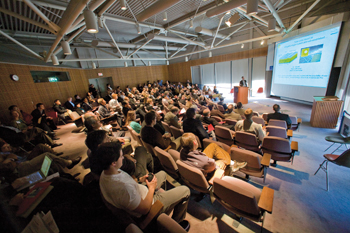
This wasn’t a room full of scientists. In fact, MBAs probably outnumbered Ph.Ds at Berkeley Lab’s first annual Technology and Inventors Expo, which brought more than 60 venture capitalists and several dozen Lab scientists under one roof. The Jan. 30 event was organized by the Technology Transfer Department and the Molecular Foundry with support from the Materials Sciences Division.
The all-day expo was a melting pot of potential. Berkeley Lab scientists showcased cutting-edge research on nanotechnology, clean energy, and energy efficiency. Investors toured the Molecular Foundry, and learned how they could advance their company’s nanotechnology research by accessing the user facility’s state-of-the-art instrumentation and expert staff. And Lab researchers got a glimpse of what it takes to shepherd an idea from the whiteboard to the marketplace.
“We hoped to demystify the Lab for investors, and demystify the world of commerce for our scientists,” says Cheryl Fragiadakis, head of the Lab’s Technology Transfer Department. “We also wanted to bring Lab researchers and venture capitalists together.”
It’s a natural fit. Venture capitalists help start-up companies commercialize innovations in materials sciences, biotechnology, information technology, and clean energy. And Lab scientists are leaders in these fields. The expo found the two groups’ common ground, in part by covering Lab research that could someday make the world a better place.
“I was surprised at how interested some of the VCs were in my research, even though it’s pretty early stage,” said James Schuck, a staff scientist at the Molecular Foundry who specializes in nanoscale optical imaging. “It was also nice to convey how exciting it is to work at the Foundry. How many other places in the world can you walk upstairs to ask a biologist a question and then walk downstairs to discuss a problem with a physicist? The VCs were very interested in this environment.”
The expo also covered the nitty-gritty of patenting a technology and launching a start-up company. Christophe Sevrain, CEO of CJPS Enterprises and former managing director of Delphi Medical, kicked off the meeting by offering an inside look at the private sector’s wishlist.
“We want a technology that fills a market need,” Sevrain said. “Technologies that make it to market have strong, relevant patent protection, and are a solution to a practical, real problem.”
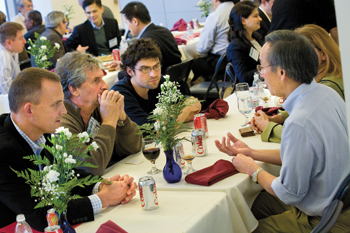
Next, Lab Director Steve Chu discussed several technologies that could shift the energy equation. He outlined current research on energy-storage technologies, batteries for plug-in hybrid vehicles, biofuels, and wind energy. He also discussed an innovative idea that could give electric vehicle owners the ability to charge their car at night when electricity is cheap, and sell electricity during the day when prices increase.
Paul Alivisatos, Materials Sciences Division Director and a veteran of three start-up companies, gave the audience a brief update on the Lab’s Helios Program, which aims to develop methods to store solar energy in the form of renewable transportation fuel. He also underscored the need to feed the tech-transfer pipeline with fundamental research.
“There is no substitute for basic science discoveries, which are needed in order to yield solutions that will provide sustainably for our energy needs,” he said. He then shared his years of experience navigating the entrepreneurial landscape, specifically directing his thoughts to Lab scientists who are considering taking the plunge.
“Tech transfer is a powerful validation of scientific accomplishment. It’s the most stringent evaluation because it is rife with difficulties,” said Alivisatos, adding that today’s scientists need to become business savvy. “We need more people who understand the world of science and engineering and the world of business. It’s important to foster the entrepreneurial spirit in young scientists.”
Next, Molecular Foundry Director Carolyn Bertozzi introduced the audience to the Foundry by pointing to its western façade, which seemed to hover in space just outside the auditorium window.
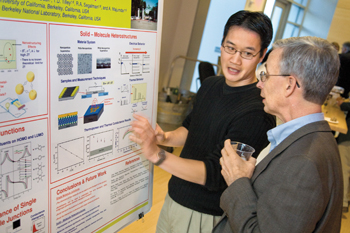 Through lectures, lunch, and a poster session, attendees of the Technology & Inventors Expo immersed themselves in both sides of the tech transfer equation: venture capitalists learned about the Lab's cutting-edge research, and Lab scientists got a glimpse of what it takes to shepherd research from the whiteboard to the marketplace.
Through lectures, lunch, and a poster session, attendees of the Technology & Inventors Expo immersed themselves in both sides of the tech transfer equation: venture capitalists learned about the Lab's cutting-edge research, and Lab scientists got a glimpse of what it takes to shepherd research from the whiteboard to the marketplace.
“The Molecular Foundry offers state-of-the-art science and collaborations with experts in a wide range of nano-science fields. It enables users to pursue their research initiatives at the highest level,” she said. She listed several energy-related research initiatives at the Foundry, including hydrogen-storage materials, photovoltaics, and nanoporous membranes. She also touched on nanotechnology’s huge market potential.
“Already, nanotechnology has had a big impact on the commercial sector, and there is a rapidly expanding nanotech industry,” Bertozzi said.
Additional talks rounded out the expo. Lab scientists discussed the future of energy efficiency research, novel structures for energy conservation and storage, energy efficient computing, nanoparticle-based drug delivery, and new materials for bone replacement and tissue engineering, among other topics.
Berkeley Lab-Led Agreement Tackles India’s Energy Shortage, and Global Climate Change
The Indian state of Maharashtra is at a crossroads. Its people endure frequent electricity blackouts due to a booming energy demand that far outpaces energy production. One solution is to build more coal-fired power plants, which are among the chief greenhouse-gas-emitting culprits of climate change. Another solution takes a different approach: reduce electricity demand, and the need for more power plants, by implementing energy-efficiency measures.
The latter choice may have an edge, thanks to a Memorandum of Understanding (MOU) facilitated by Berkeley Lab scientists that aims to export California’s lessons in adopting energy efficiency strategies to the state of Maharashtra. Maharashtra leads India in energy consumption.
The MOU, which is the only one of its kind between energy regulators in the U.S. and India, was signed in December, 2007, by Pramod Deo, chairman of the Maharashtra Electricity Regulatory Commission; Berkeley Lab Director Steve Chu; Art Rosenfeld, Commissioner of the California Energy Commission; and Dian Grueneich, Commissioner of the California Public Utilities Commission.
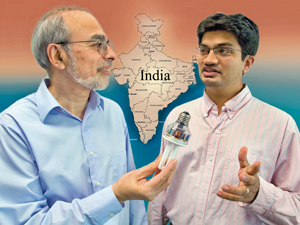 A collaboration spearheaded by Jayant Sathaye (left) and Amol Phadke of Berkeley Lab's Environmental Energy Technologies Division will share California's energy-efficiency know-how with the Indian state of Maharashtra. (Photo by Roy Kaltschmidt, Creative Services Office)
A collaboration spearheaded by Jayant Sathaye (left) and Amol Phadke of Berkeley Lab's Environmental Energy Technologies Division will share California's energy-efficiency know-how with the Indian state of Maharashtra. (Photo by Roy Kaltschmidt, Creative Services Office)
“The idea is to meet a significant portion of Maharashtra’s electricity growth through energy efficiency, not by building power plants,” says Jayant Sathaye of the Environmental Energy Technologies Division (EETD), who engineered the collaboration with fellow EETD scientist Amol Phadke. Sathaye is head of EETD’s International Energy Studies group. In addition to facilitating the MOU, Berkeley Lab, one of the world’s premier research institutions in energy and environmental technology policies, will provide technical support to Maharashtra’s energy regulators and utility companies.
The collaboration is designed to help Maharashtra meet a 5,000-megawatt shortfall in energy production, which sparks power outages that hamstring the state’s economy and force businesses to use polluting, back-up diesel generators. The signatories hope to help Maharashtra erase this deficit by sharing California’s energy-efficiency programs and practices, which have been instrumental in restraining California’s per capita electricity consumption to a level that is almost half the per capita electricity consumption of the U.S.
The document lays the groundwork for an exchange of expertise between the parties and for embarking on joint research activities. Together, they’ll explore policies on energy efficiency, demand-side management, renewable energy development, innovative electricity regulation, and integrated resource planning, among other areas. Incentive programs that drive the adoption of compact fluorescent lamps, efficient industrial processes, solar water heaters, and energy-efficient refrigerators, electric motors, and irrigation pumps will be considered.
“The MOU will also help California, where we have a great concern in mitigating climate change,” adds Sathaye. “India’s energy consumption is growing at approximately nine percent per year. We need to help them find ways to solve this problem by slowing the building of more power plants.”
The agreement has its origins in a 2005 study conducted by Sathaye and Phadke that quantifies what the people of Maharashtra know all too well: the state suffers from a severe energy shortage. Located in southwestern India on the Arabian Sea, Maharashtra has a population of nearly 97 million people. It’s the most developed state in the nation and serves as the financial and entertainment capital of the country. But the state’s utilities only generate about 12,000 megawatts of electricity, far short of the 17,000 megawatts demanded by domestic, industrial, and agricultural sectors. Daily blackouts are a fact of life.
“When we saw this, we immediately thought of the blackouts forecast in California for the summer of 2001,” says Phadke. “We also thought of the energy-efficiency solutions that helped California get through this period.”
Soon after California’s electricity crisis erupted, for example, the state unveiled the 20/20 energy conservation program, which gave customers a 20-percent reduction in utility bills if they achieved a 20-percent reduction in consumption. In addition, many customers qualified for a rebate by purchasing high-efficiency appliances. Analysis conducted by Berkeley Lab scientists determined that these measures were critical in avoiding blackouts.
 The Indian state of Maharashtra and its capital, Mumbai, face increasing pollution and more blackouts unless energy demands can be addressed efficiently. (Source photo by Mark Jacobs, EETD)
The Indian state of Maharashtra and its capital, Mumbai, face increasing pollution and more blackouts unless energy demands can be addressed efficiently. (Source photo by Mark Jacobs, EETD)
But will similar solutions work in Maharashtra? There’s good reason for optimism. Like California, Maharashtra is progressive when it comes to implementing energy-efficiency practices, and its electricity regulatory apparatus is analogous to that of California’s. With this in mind, Sathaye and Phadke brought the two states’ energy commissions together, and mapped out a framework that fosters an open exchange of ideas.
“We’d like to take the energy-efficiency mechanisms that helped us prevent the rolling blackouts in the summer of 2001, and introduce them to other parts of the world,” says Sathaye.
Fortunately, energy-efficiency strategies can be up and running quickly — sometimes in a matter of weeks — compared to the five to ten years it takes for a new power plant to come on-line. And the MOU is already in action. Berkeley Lab EETD scientist Ranjit Bharvirkar is currently in Maharashtra, where he’s advising electricity regulators on implementing demand-response protocols, which save energy by shifting a consumer’s electricity loads from peak times to off-peak times. And fellow EETD scientist Ed Vine, a leader in monitoring and evaluating the efficiency of utility companies, will train and provide assistance to Maharashtra’s utility companies.
The next step in the collaboration is a workshop to be held in Maharashtra in March on energy efficiency and resource planning. The MOU is funded by the U.S. Department of Energy and the U.S. Department of State in support of the goals of the Asia-Pacific Partnership on Clean Development and Climate.
Berkeley Lab Leads EMCal, a Major “Pre-Upgrade” for ALICE
CERN’s Large Hadron Collider (LHC) will soon begin searching for the Higgs particle and other new physics in energetic proton-proton collisions. But for four weeks each year the LHC will switch to lead-lead collisions, studying the evolution and structure of nuclear matter at high temperature by colliding massive ions. A huge detector named ALICE (A Large Ion Collider Experiment) is being built specifically to study what happens when lead ions collide.
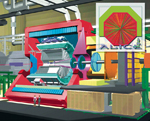 By using the Large Hadron Collider to collide high-energy lead nuclei and produce an extremely hot, dense state of matter, CERN’s ALICE will investigate the physics of the quark-gluon plasma.
By using the Large Hadron Collider to collide high-energy lead nuclei and produce an extremely hot, dense state of matter, CERN’s ALICE will investigate the physics of the quark-gluon plasma.
“ALICE was designed to study the quark-gluon plasma, a fundamental state of very hot, very dense matter that filled the universe a few microseconds after the big bang,” says Peter Jacobs of Berkeley Lab’s Nuclear Science Division (NSD). “One way to recreate that state is to slam massive particles into each other at high energies. Neutron stars would be good, but in the laboratory we have to settle for heavy atomic nuclei, like gold or lead.”
One thing ALICE was not originally designed to do, however, was study the phenomenon called “jet-quenching.” When ALICE was just getting started back in the late 1990s, jet-quenching hadn’t yet been discovered at Brookhaven’s Relativistic Heavy Ion Collider (RHIC).
“When particles like protons collide at high energy, pairs of their constituent quarks or gluons may slam into each other and scatter back-to-back, quickly breaking up again into a ‘jet’ or spray of particles such as pions and kaons,” Jacobs explains.
The fireball from a collision of two massive nuclei like lead (or gold, the nuclei RHIC collides) is bigger, hotter, and much denser than that from a collision of two protons. “RHIC was the first accelerator in which jets could be seen in heavy-ion collisions,” Jacobs says.
RHIC’s STAR detector depends on a Time Projector Chamber built at Berkeley Lab, a type of detector invented by David Nygren of the Physics Division. Data from STAR and other RHIC detectors revealed something new, says Jacobs. “We observed something predicted but never before seen in jet physics: jet quenching.”
The farther a jet has to push through the dense nuclear matter of a heavy-ion collision, the more energy it loses. If the interaction with matter is strong enough, it may not escape the fireball as a jet at all.
The theory linking jet quenching to the quark-gluon plasma was developed by Berkeley Lab’s Xin-Nian Wang and Miklos Gyulassy (who was with Berkeley Lab at the time and is now at Columbia University).
“How the jets propagate through the fireball, and how much quenching occurs, tells us a lot about the properties of the hot matter generated in the collision,” says Wang.
 The 25-ton support structure for the EMCal was lowered 50 feet to the ALICE experimental cavern and installed in November, 2007.
The 25-ton support structure for the EMCal was lowered 50 feet to the ALICE experimental cavern and installed in November, 2007.
Meanwhile ALICE was already under construction, anticipating the day when the LHC would accelerate lead ions to energies 30 times greater than RHIC. ALICE will be able to track the roughly 8,000 charged particles produced in each lead-lead collision, but to store all that mostly-unremarkable data would soon overwhelm the system. Studying jet quenching adequately meant ALICE would have to incorporate a trigger to rapidly signal its detectors and extract the potentially interesting jet events from a noisy background. Enter the EMCal.
“In the early 2000s, American nuclear scientists, including Thomas Cormier of Wayne State University and Grazyna Odyniec in our own NSD, formed a U.S. ALICE collaboration to explore the idea of a calorimeter for ALICE,” says Jacobs, a member of the international Project Management Board for EMCal, ALICE’s Electromagnetic Calorimeter. The collaboration was led by Odyniec from 2001 to 2006.
Joseph Rasson of Berkeley Lab’s Engineering Division, the international EMCal Technical Coordinator, says that DOE’s Office of Nuclear Physics got behind the project in 2004. Because ALICE was already well along, the EMCal was initially launched as a kind of “pre-upgrade” while its design was still being explored.
“The first chunk of money came with the instructions to build a support structure, although we didn’t have a project yet,” Rasson says. The collaboration had to move fast to install the support frame before ALICE got too far along. The finished frame was engineered by a team led by John Bercovitz of Engineering and built by an Italian company; five meters long and weighing 25 tons, it was successfully installed in November, 2007.
Meanwhile the design of the EMCal detector itself came together in detail. Each channel of the calorimeter is a tower of 77 alternating layers of lead plates and plastic scintillators, coupled to optical fibers in a “shashlik” configuration (resembling the Middle Eastern delicacy better known as shish-kebab); the fibers are read out by a sensor called an avalanche photodiode. The towers are assembled into modules and the modules into supermodules, each weighing about nine tons.
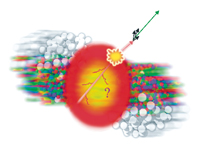 When back-to-back jets of particles are produced inside the fireball of colliding heavy nuclei, one jet may be unable to escape.
When back-to-back jets of particles are produced inside the fireball of colliding heavy nuclei, one jet may be unable to escape.
Within weeks of the successful installation of the support frame, the EMCal passed DOE’s review stages (CD 2 and 3, conducted simultaneously) and was approved for construction. The Office of Nuclear Physics in DOE’s Office of Science has committed $13.5 million to the EMCal, about 70 percent of the total cost, with the French and Italian partners supplying the remainder. In addition to Berkeley Lab and Wayne State University, the EMCal project collaboration includes Yale University and Oak Ridge National Laboratory, plus half a dozen other institutions in the U.S., along with Nantes, Grenoble, and Strasbourg Universities in France, the University of Catania and the Institute of Nuclear Physics at Frascati in Italy, and CERN in Switzerland.
“The EMCal is a significant contribution to the ALICE experiment and will give U.S. scientists the opportunity to explore fundamental questions about the quark-gluon plasma that ALICE and the LHC make uniquely possible,” says James Symons, Director of the Nuclear Science Division. “And Berkeley Lab’s leadership of the project helps maintain this lab at the forefront of nuclear physics research.”
Berkeley Lab participants in ALICE’s EMCal Project include Peter Jacobs, Spencer Klein, Grazyna Odyniec, Mateusz Ploskon, Hans Georg Ritter, Sevil Salur, and James Symons of NSD; Joseph Rasson and Dennis Peterson of Engineering, and Dianna Jacobs of the Berkeley Lab Project Office.
This Week in Lab History
It was 15 years ago this week that the Lab’s venerable Bevatron/ Bevelac ended its nearly 40-year run as the workhorse of high-energy and heavy ion physics. The following story ran in the Feb. 26, 1993 Currents commemorating the occasion.
Nearly 100 current and former LBL employees gathered at the Bevatron on Saturday, Feb. 21, 1993 to watch Ed Lofgren turn off the beam for the last time.
Lofgren, who was in charge of the machine from its completion in 1954 until his retirement from the post in 1979, pushed a button that someone long ago labeled “atom smasher offer.” In so doing, he brought to an end a four-decade era of accomplishments that are unrivaled in the fields of high-energy and heavy-ion physics. Early discoveries at the Bevatron—or Bevalac, as it was called after its linkage with the SuperHILAC linear accelerator in the 1970s—resulted in four Nobel prizes.
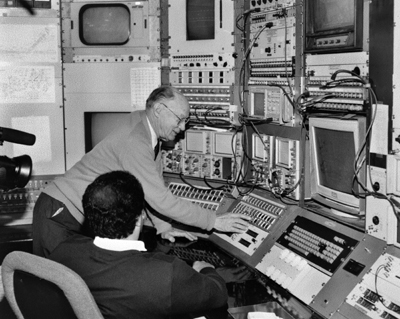 In this 1993 photo, Lab veteran Ed Lofgren turns off the Bevatron beam for the last time after 39 years of operation. In the foreground is operator Marco Monroy, who manned the Bevatron's last shift, securing the machine's motor generators--and its place in history.
In this 1993 photo, Lab veteran Ed Lofgren turns off the Bevatron beam for the last time after 39 years of operation. In the foreground is operator Marco Monroy, who manned the Bevatron's last shift, securing the machine's motor generators--and its place in history.
It was first announced that the particle accelerator had reached the end of its career in October 1992, following several reprieves as new areas of research were entered. All told, the accelerator made major contributions in four distinct areas of research: high-energy particle physics, nuclear heavy-ion physics, medical research and therapy, and space-related studies of radiation damage and heavy particles in space.
On hand for the final “turn-off,” which was videotaped for inclusion in an LBL-produced video about the Bevalac, were many of the people instrumental in the building and start-up of the accelerator. Among these were William Brobeck, chief designer of the Bevatron, Bruce Cork, Walt Hartsough, Warren Chupp, and Bob Richter.
Owen Chamberlain, who received a Nobel prize for his discovery of the anti-proton at the Bevatron, joined the group, as did project collaborator Clyde Wiegand. Rick Gough, acting AFRD director; William Barletta, new AFRD director as of March 1; Nuclear Science Division director James Symons; Klaus Berkner, associate laboratory director for operations; and Herb Steiner, chair of the UC Berkeley Physics Department, were all present for the festivities. Ben Feinberg, Bevalac operations program head, and Fred Lothrop, former scheduling coordinator, were among the many other present and former Bevalac staff and experimenters on hand.
One touching moment came just after Lofgren shut the machine down. “Taps” wafted out over the PA system.
Shortly after the beam was turned off, power to the magnets was turned off by Warren Faust, head of the motor-generator crew, and retired engineer Harold Vogel. While the motor generators audibly wound down, the group was in telephone contact with former motor-generator engineer Bob Frias.
Feinberg noted that the shutdown came 39 years to the week after a beam was first circulated in the Bevatron. The last experiment to be run was led by a collaboration from Japan, headed by Isao Tanihata. The experiment was to study the properties beams of radioactive isotopes created at the Bevatron.
-- Mary Bodvarsson
Berkeley Lab Science Roundup
A First in Microfluidic MRI
 A signal obtained via parahydrogen- polarized imaging is hundreds of times stronger than standard MRI.
A signal obtained via parahydrogen- polarized imaging is hundreds of times stronger than standard MRI.
Using magnetic resonance imaging (MRI) to visualize gas-phase reactions could improve future microcatalytic reactors, including “labs-on-a-chip.” Alexander Pines led a team including Louis Bouchard and Scott R. Burt of the Materials Sciences Division, with colleagues from India and Russia, using hyperpolarized parahydrogen gas to enhance MRI of microscale catalytic reaction products. They demonstrated MRI’s unique ability to measure velocity- and spatially-dependent quantities by tracking gases and liquids in microfluidic devices and in the void spaces of a tightly packed catalyst reactor bed, without the use of tracer particles or gases. Moreover, says Burt, “Our results indicate that our approach to using parahydrogen can be extended to other chemical reactions beyond hydrogenation, which significantly broadens the impact and potential use of our technique.” The results appear in the Jan. 25 issue of Science.
Mysteries of Genome Regulation
 This diagram of a fruit-fly embryo has been color-coded to indicate the expression levels of various gene regulators.
This diagram of a fruit-fly embryo has been color-coded to indicate the expression levels of various gene regulators.
Michael Eisen, Mark Biggin, Xiao-Yong Li, and Stewart MacArthur of the Lab’s Genomics Division have found that transcription factors that choreograph early development in the fruit fly bind to a surprisingly wide array of genes, but that much of this binding has no effect on gene expression. “There is a natural tendency to assume that if something happens in a cell it must be important,” says Eisen, “but our results show that this assumption is not always correct, and this should be instructive for anyone working in any area of functional genomics.” The work appeared online Feb. 12 in PLoS Biology.
Arming a Virus for Stealth Delivery
 The capsid of an MS2 bacteriophage virus can be decorated with peptides that perform a number of functions.
The capsid of an MS2 bacteriophage virus can be decorated with peptides that perform a number of functions.
Matthew Francis of Materials Sciences, working with Zachary Carrico and Dante Romanini and colleagues at UC Berkeley, using combinatorial synthesis and screens for viruses, has found a number of synthetic peptides that can act as ligands to cellular receptors and localize in specific tissue types. The researchers have tested the approach by attaching several peptides to the outer shell of MS2, a type of virus called a bacteriophage (“bacteria eater”), then used the virus to target human cells. The technique may be able to incorporate even nonbiocompatible compounds for medical imaging, therapeutic drugs, and other applications in both biochemical and materials science fields. The work appeared online Jan. 29 in ChemComm, a journal of the Royal Society of Chemistry.
First Plankton, then Animals
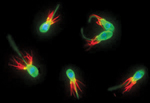 The plankton Monosiga brevicollis seen under the microscope.
The plankton Monosiga brevicollis seen under the microscope.
The newly sequenced genome of a one-celled planktonic marine organism called Monosiga brevicollis highlights evolutionary changes that accompanied the jump from one-celled life forms to multicellular animals like ourselves. Daniel Rokhsar of the Lab’s Genomics Division and DOE’s Joint Genome Institute worked with UC Berkeley biologist Nicole King and colleagues to develop a draft genome of the choanoflagellate and compare it to the genomes of multicellular animals. M. brevicollis last shared a common ancestor with multicellular creatures between 600 million and a billion years ago. “Because the fossil record is not there,” says Rokhsar, “choanoflagellates really are a unique window back in time to the origin of animals and humans.“ The researchers report their findings in the Feb. 14 Nature.
Did Edison Foresee the Information Age?
 Data centers use almost twice the power needed for data processing alone because of AC-DC-AC conversions.
Data centers use almost twice the power needed for data processing alone because of AC-DC-AC conversions.
DC’s great champion Thomas Edison may be earning new respect from people who manage data centers. Bill Tschudi of the Environmental Energy Technologies Division led a study finding that, in data centers, converting from AC to DC and back to AC almost doubles the power needed for data processing, and at the same time generates a lot of heat that exacerbates the problem of keeping the equipment cool. Tschudi recommends redesigning these facilties for one-step conversion from AC to DC. Details are in a report sponsored by the California Energy Commission.
Bad Filters Make for Sick Buildings
Sick building syndrome, more formally known as building-related symptoms (BRS), increases when there’s more ozone in the outside air. That may not seem surprising, but another finding by Michael Apte, Ian Buchanan, Mark Mendell, and Anna Mirer of EETD, using data collected by EPA, found something stranger: if the building uses air filters made of polyesters or other synthetics in their ventilation systems, BRS can get worse, including irritation of eyes, nose, throat, respiratory tract, and skin, as well as headache and fatigue. The two reports appear in the journal Indoor Air.
Lab Inventors Collect Royalty Checks
Transfer of technology to industry provides funding for lab and research
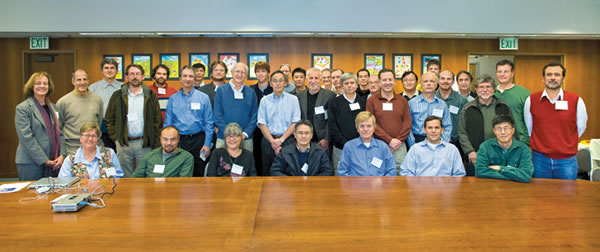 Lab researchers gather with Tech Transfer representatives to receive the fruits of their labor—royalty checks for their inventions. Back Row, left to right: Nigel Moriarty, Ralf Grosse-Kunstleve, Jian Jin, Petrus Zwart, Jay Groves, Fred Buhl, Paul Luke, Paul Alivisatos, Bill Kolbe, Michael Commer, Steve Holland, Ted Sun, Pavel Afonine, Christopher Elkin, Joe Orr, Len Pennachio. Second row: Cheryl Fragiadakis (Technology Transfer Office), Mark Modera, Paul Adams, Nick Sauter, John Clarke, Director Steve Chu, Wladyslaw Walukiewicz, David Humphries, Martin Pollard, Ender Erdem, Fred Winkelmann, Greg Newman. Front Row: Viviana Wolinsky (Technology Transfer Office), Jonathan Maltz, Martha Stampfer, KinMan Yu, Bob Nordmeyer, Derek Yegian, and Duo Wang. Not pictured: Bob Bergman
Lab researchers gather with Tech Transfer representatives to receive the fruits of their labor—royalty checks for their inventions. Back Row, left to right: Nigel Moriarty, Ralf Grosse-Kunstleve, Jian Jin, Petrus Zwart, Jay Groves, Fred Buhl, Paul Luke, Paul Alivisatos, Bill Kolbe, Michael Commer, Steve Holland, Ted Sun, Pavel Afonine, Christopher Elkin, Joe Orr, Len Pennachio. Second row: Cheryl Fragiadakis (Technology Transfer Office), Mark Modera, Paul Adams, Nick Sauter, John Clarke, Director Steve Chu, Wladyslaw Walukiewicz, David Humphries, Martin Pollard, Ender Erdem, Fred Winkelmann, Greg Newman. Front Row: Viviana Wolinsky (Technology Transfer Office), Jonathan Maltz, Martha Stampfer, KinMan Yu, Bob Nordmeyer, Derek Yegian, and Duo Wang. Not pictured: Bob Bergman
People, Awards, and Honors
Three Scientists Join Engineering Academy



Three Berkeley Lab researchers are among 65 new members elected to the National Academy of Engineering, considered one of the highest professional distinctions for an American engineer. New members include Enrique Iglesia (Chemical Sciences) for his contributions to the understanding of catalyst structure-function relationships, the development of novel catalysts and leadership in the field of catalysis (left photo); Robert Sawyer (EETD) for his work in reducing energy consumption, improving the environment and for contributions to our understanding of air pollution (center); and James Sethian (Computational Research) for the development of efficient methods of tracking moving interfaces.
Librarians present Award To Climate Report

The first of four 2007 reports by the Intergovernmental Panel for Climate Change, winner of the Nobel Peace Prize last year, was “The Physical Science Basis of Climate Change” from Working Group I, which concluded with “very high confidence” that human activity has caused past and future global warming. At the annual meeting of the American Meteorological Society held last month in New Orleans, that report was recognized by the Atmospheric Science Librarians International (ASLI) as the year’s top “high impact comprehensive publication.” Among its lead authors were Bill Collins and Inez Fung of Earth Sciences and Surabi Menon of the Environmental Energy Technologies Division.
Another Energy Award For Molecular Foundry
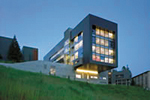 Type Ia supernovae are brighter than whole galaxies. Their measurement led to the discovery of dark energy.
Type Ia supernovae are brighter than whole galaxies. Their measurement led to the discovery of dark energy.
The Sustainable Buildings Industry Council (SBIC) has chosen Berkeley Lab’s Molecular Foundry as first-place winner of the Beyond Green 2007 High Performance Building Award. Lab representative Jim Krupnick accepted the honor yesterday in Washington on behalf of the Foundry and its architects, SmithGroup of San Francisco. The Beyond Green awards recognize initiatives that shape and catalyze the high-performance building market, as well as the real-world application of high-performance design and construction practices. The Foundry recently received the LEED “Gold” certification for “green” building design excellence.
Energy Expert Lauded For Environment Efforts

Mark Levine, with Berkeley Lab’s Environmental Energy Technologies Division (EETD), has been awarded the Obayashi Prize for his “many years of research on the global environment and global warming,” and for “impressive achievements in research related to energy-efficient construction technologies, technology for control of indoor air pollution, and clean energy technologies.” Levine is the former director of EETD and is currently leader of the China Energy Group. He is the fifth recipient of this prize, which will be awarded at a ceremony in Japan in October.
Lab’s Bissell Namesake Of New Research Award
At the recent Symposium on Frontiers in Cell Migration in Cancer, organized by the Institute of Molecular Pathology and Immunology at Portugal’s University of Porto, an award named after Berkeley Lab Senior Scientist Mina Bissell was unveiled. Bissell then presented the first-time award to Leonor Beleza, president of the Champalimaud Foundation. The award will be given every two years to a scientist who “like Bissell, has a devoted successful, lifetime research career that has transformed our perception of a topic.”
Pinar Elected Secretary Of SIAM Activity Group
Ali Pinar, a researcher in the Lab’s Scientific Computing Group, has been elected to serve as secretary for the Society for Industrial and Applied Mathematics (SIAM) Activity Group on Supercomputing. His two-year term began on Jan. 1. Pinar’s research focuses on combinatorial scientific computing. The SIAM Activity Group on Supercomputing provides a forum for computational mathematicians, computer scientists, computer architects and computational scientists to exchange ideas on mathematical algorithms and computer architecture needed for high-performance computing.
New Coordinator For Activities Group
The Lab’s Employee Activities Association (EAA) has a new leader for 2008. Loida Bartolome-Mingao, the Lab’s Health Care Facilitator and Wellness Coordinator, will assume the role from Arabella Schmidt. Mingao formerly served as coordinator from 2000-2002. The EAA, which is sponsored by the Lab’s Human Resources Department, offers a range of cultural, educational, recreational, and social activities for Lab employees, retirees and their families.